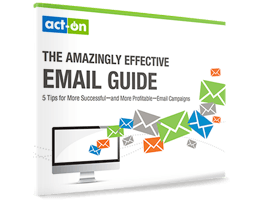Thought Leader Life is a web series spearheaded by Mitchell Levy, CEO and Thought Leader Architect at THiNKaha and Chief Aha Instigator at the Aha Amplifier, to spotlight today’s thought leaders. Recently Act-On Software’s Director of Digital Marketing, Linda West, and Rachel Rosin, Act-On’s Marketing Programs Manager, were guests on the program, talking about best practices in modern email marketing. Paula Chiocchi, founder and the B2B email marketing diva at Outward Media, guest-hosted with Mitchell. This is part 1 of an edited transcript of the conversation; you can catch the entire discussion here:

MITCHELL: Hi, this is Mitchell Levy, and welcome to episode 86 of Thought Leader Life. I’m really excited for the month. We’ve got Paula Chiocchi, who is the founder and the B2B email marketing diva at Outward Media. We’re talking about nothing less than the successful moving forward of email. Paula, great to have you as co-host for the month.
PAULA: Thank you, Mitchell. Happy to be here.
MITCHELL: It’s an interesting time between thought leadership and email marketing and what you do there. I want to introduce our guests. We have Linda West, who’s the digital marketing director at Act-On. Linda, great to have you.
LINDA: Good to be here.
MITCHELL: And we also have Rachel Rosin, who’s the marketing programs manager at Act-On. Rachel, great to have the two of you with us.
RACHEL: Pleasure to be here.
Is Email Marketing Dead?
MITCHELL: The softball question I want to start with is, I often hear people say, hey social media is in, email marketing is dead. Obviously we know this is not true. But what’s your take on that statement?
LINDA: I would say that it is true to a certain extent. Email marketing as we knew it is dead. But email marketing generally is absolutely not dead. It has evolved, it is new, it is different, but it’s not dead.
RACHEL: I’d agree with that. It’s not dead. It’s just the tactics have changed now. And the measurements for success have also changed as well. So it’s not so much about email itself being dead, but just shifting our focus and focusing on different things for email.
PAULA: How have you seen the measurements for success change?
RACHEL: We’ve moved away from when it was very, very common to focus on your open rates. And now I think that the most important measurement of success is your clickthrough rate. How is your audience engaging with the different emails that you’re sending out? What are they clicking on? Are they taking that extra step? Because now it’s not so much about just getting your message out. It’s about getting people to engage with it.
LINDA: Even further to that, instead of focusing on vanity metrics like open rates, it’s now how many leads are you generating from your email programs? And how many deals are you closing on the back of that? And how is email influencing the complex sale? And how is email influencing that buyer’s journey that’s probably longer than one email? So email is being used in a really unique way. Again it’s moving beyond those vanity metrics and looking at deeper things like tying email to one deal, and tying email to lead generation, and clickthrough rates and engagement.
Engaging Email Across Channels
PAULA: Do you see your clients trying to use email also with the social media channels now? I guess everybody thinks that’s the new big thing, social media.
LINDA: I would say so. When you move beyond just trying to get people to engage in that channel, and you move into this mindset that there’s this larger world for you to play in. I’ve seen campaigns that encourage as their call to action not buy now, but – hey tweet this, let’s get you engaged with this conversation.
PAULA: That’s cool. I haven’t seen that.
LINDA: There are a lot of cool tools out there that you can use. Click to Tweet is a great one, we’ve used that quite a bit in our own programs. There are really interesting ways that you can just use email to help people engage with your brand across channels. It doesn’t have to just be, “Hey here’s an email, interact with this email.”
RACHEL: I think it’s very common now, especially if you’re promoting a white paper or a blog post or anything. It’s very easy to do a click to tweet function. And you have a message ready to go with a link to that asset. And your viewers can go ahead and share it automatically. So that’s definitely a great way to help set engagement.
LINDA: Now you’re able as a marketer – with all this technology available to you, like marketing automation, and analytics and tracking information, –you are not just tied to what did this person do in the email. You can track every single behavior that that person takes in every channel that you’re promoting in, so you’re not tied to the metrics within that channel.
How do you build engagement?

PAULA: It’s hard to do the attribution because it goes across all the channels. But we see email as a driver to get to that attribution. When we first started in the email business in 2004, our open rates averaged from six percent to all the way up to 30 percent sometimes. Now they’ve kind of settled back although not as low as what typical industrial direct mail is. But what do you do to help your clients get open rates up?
LINDA: It’s all about engagement. It’s all about understanding your audience. It’s all about sending the right message at the right time to the person that you’re trying to reach. So it’s beyond just technically what’s in your email or technically how is it delivered. It’s really about who are you talking to and what are they interested in hearing at that point in time. Are they a late stage buyer who’s about to make a purchase from you? Or have they never heard of your brand before? Those two different types of people want different things, inherently. So it’s really more about understanding your audience than anything else.
RACHEL: The different types of messages also have different open rates. I was looking at some stats prior to this conversation, and I saw on eMarketer that triggered emails have higher open rates than your normal standalone emails. Different types of messages have different results.
PAULA: That’s a really good point.
MITCHELL: So in the buyer’s journey, if the buyer is actually doing something that will encourage them to get an email response, a couple things have to happen. First, you need to be able to give the email response immediately, right? Not within a couple hours or within a day. Second, if they actually respond to that, you want to respond again, right? What I’m hearing you say is that you keep focusing and referencing “know your audience” and “understand the buyer’s journey,” right? And so what that means is, it’s not about yourself, it’s not about your company, it’s not about what you say. It’s all about how you say it in such a way that your prospective buyer – now I call him a future advocate, but your future advocate and current advocates are excited about who you are and dealing with you.
LINDA: Absolutely. That’s a really good way to put it. It’s like a relationship. You can’t go on a date and ask somebody to go on vacation with you and marry you on the first date. This is definitely not the best approach. But if you develop a long term relationship and understand the person and communicate things at the right time, it’s all going to work out. And eventually that person’s going to love you and maybe marry you and say yes. But it’s a long process. You have to be conscientious of that other person and your own value and all of those good things.
PAULA: I agree with that because the B2B close cycle has gone from three to six months to now six to eight months, even a year. So it’s about nurturing them along the journey.
LINDA: Absolutely. And even beyond that first purchase, it’s like you said, there’s future promoters. How are you engaging your current customer base with email to adopt more features within your product, or to use your product, to love your product more, to promote it, to share it with their colleagues or their friends?
PAULA: Click to tweet.
LINDA: Yes. Click to tweet.
[LAUGHTER]
Responsive Design Considerations
MITCHELL: I see a lot of the fundamentals of success today, many people are talking about that long term mailing list they have. Even if you look at Jeff Walker and Launch, what he’s really talking about is building a good mailing list so that you can then continue to launch new products over time. And you may actually end up with something that’ll be super successful. Paula and I were talking before. One of the things we were thinking about is responsiveness. And how do you create the type of email messages and an approach that will increase the responsiveness of those that you’re reaching. Obviously you need to know who they are. But what are some of the tricks and techniques you guys use?
LINDA: Well one, ironically, is responsive design. [LAUGHTER] Responsive design is technically an

HTML email that’s delivered that will actually change its format based on the device that the viewer is using. Over 50 percent of all emails are opened on mobile devices now. If the person that’s receiving the email can’t read it and interact with it efficiently because they’re on a mobile phone, then you’ve already lost the battle. Responsive design is one new way that’s emerging that some marketers are starting to adopt to make sure they’re hitting people in all the places where they’re going to be interacting with email.
The emergence of mobile is huge. And it’s impacted the email channel probably the quickest. There’s more traffic from mobile devices into the email channel than most other channels at this point.
PAULA: And it’s probably just going to get bigger because the millennial generation, that’s where they’re living, on the mobile device.
LINDA: People spend more time on their mobile phone now than they do watching TV, than they do at their desktop computer. It is the dominant location for media consumption.
Thoughts on video and animation in emails
PAULA: I think I saw recently the mobile figure for the millennial buyers for B2B is approaching somewhere between 40 and 50 percent. It was just 20 percent about a year ago. That is where they’re living, on their phone. What do you think about the future? I’ve been reading about the emergence of video in email.. What do you think about video in email? Are you already testing that with your clients?

RACHEL: Yes. Video’s a great way to stand out from the crowd because you have this constant barrage of emails that are hitting everybody’s inbox daily. Hundreds of emails. So it’s really a good way to stand out. There are just some technical considerations for that now though, as not every email service provider will support video within the email. So you have to be careful in the way that you’re positioning those, who you’re sending them to, and make sure that the image itself as a standalone will work as well without that video in case it doesn’t play. [For instance, Outlook does not support video, so if you are sending animations or video to outlook clients, then you need to make sure that the email still looks good and conveys your message if that animation or video isn’t able to play.]
LINDA: Some common ways around that too, like animated GIFs are another way to create action in your emails. We do that a lot in our emails and it’s really effective for drawing attention to your messages.
RACHEL: We did a head-to-head test – an A/B test; one email with a static banner, one email with an animated banner. There were more click-throughs and more engagement on the animated banner.
MITCHELL: How big – for the animated GIF and the banner, how many images were behind it? How easy was that to create? And what did it show versus the static one?
RACHEL: It was really easy to create. There are some free resources online and I learned how to do it in an afternoon using Photoshop. There are tutorials out there that are very easy to figure it out, and it doesn’t have to be something that’s incredibly complicated. It’s just adding some element of movement that draws your eye and really captures the attention of whoever’s viewing the message.
LINDA: It adds the cool factor to your message.
RACHEL: Yes.
[LAUGHTER]
PAULA: It adds a cool factor without going to an agency to create it for you.
LINDA: Exactly, yes.
What’s on the horizon for email marketing?
PAULA: What else do you think that we should know that’s up and coming for email? What are you guys sensing?
LINDA: There are a lot of interesting programmatic components of email. Lead nurturing is becoming more and more important, and more and more integral to a lot of businesses, especially those that have longer sale cycles. So that’s huge. And understanding your buyer’s journey and being able to set up trigger messages and lead nurturers that really mirror that journey and help people along. It’s about really educating and engaging buyers versus the hard sell. And that is true across all of marketing now, but especially in email.
PAULA: Do you see any integration between online display and email marketing? Do you have any clients doing that?
LINDA: Absolutely. There’s a lot of cool functionality out there where you can mirror emails on ad networks, where you can bcc an outbound email from a sales rep and it’ll go across all different ad networks. So there’s really interesting stuff that’s coming out. It’s amazing what’s happening now. It really points to this larger picture of the marketing technology ecosystem, which is growing. It’s incredible the types of technology that are available to marketers now, that connect with email and all kinds of other channels.
It can get really complicated for marketers. But I think what’s really important is to have tools that play well with others. Because there’s so much great technology out there, you want to adopt pieces of technology that are going to integrate really well with your other pieces of technology. Because again, email is one channel out of many. And they all have to play nice and interact with each other so that you have good reporting.
Stay tuned for “Modern Email: Still Winning Friends and Influencing People: Part 2”, coming soon!
In the meantime … learn five tips for more successful – and more profitable – email campaigns with your free copy of Act-On’s Amazingly Effective Email Guide.
